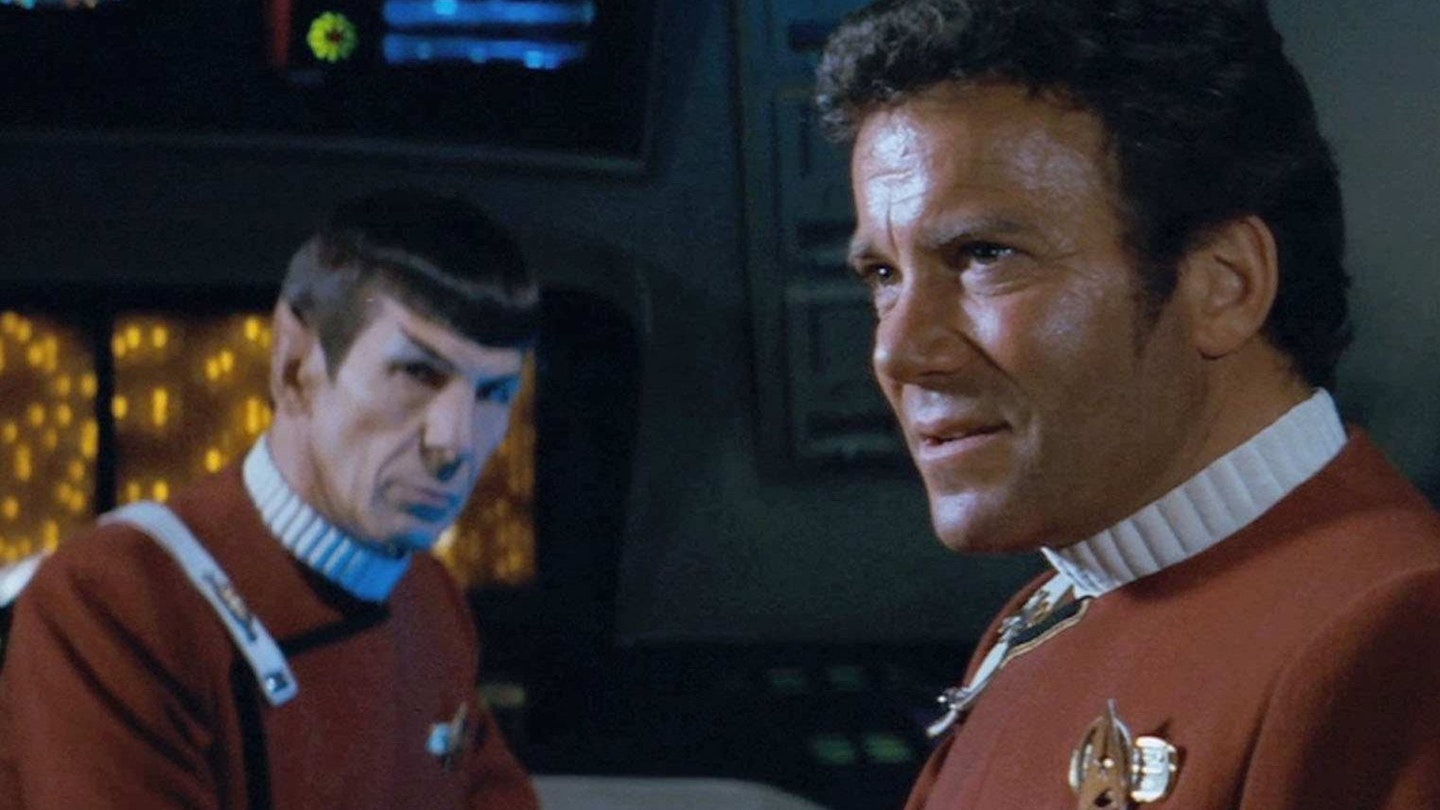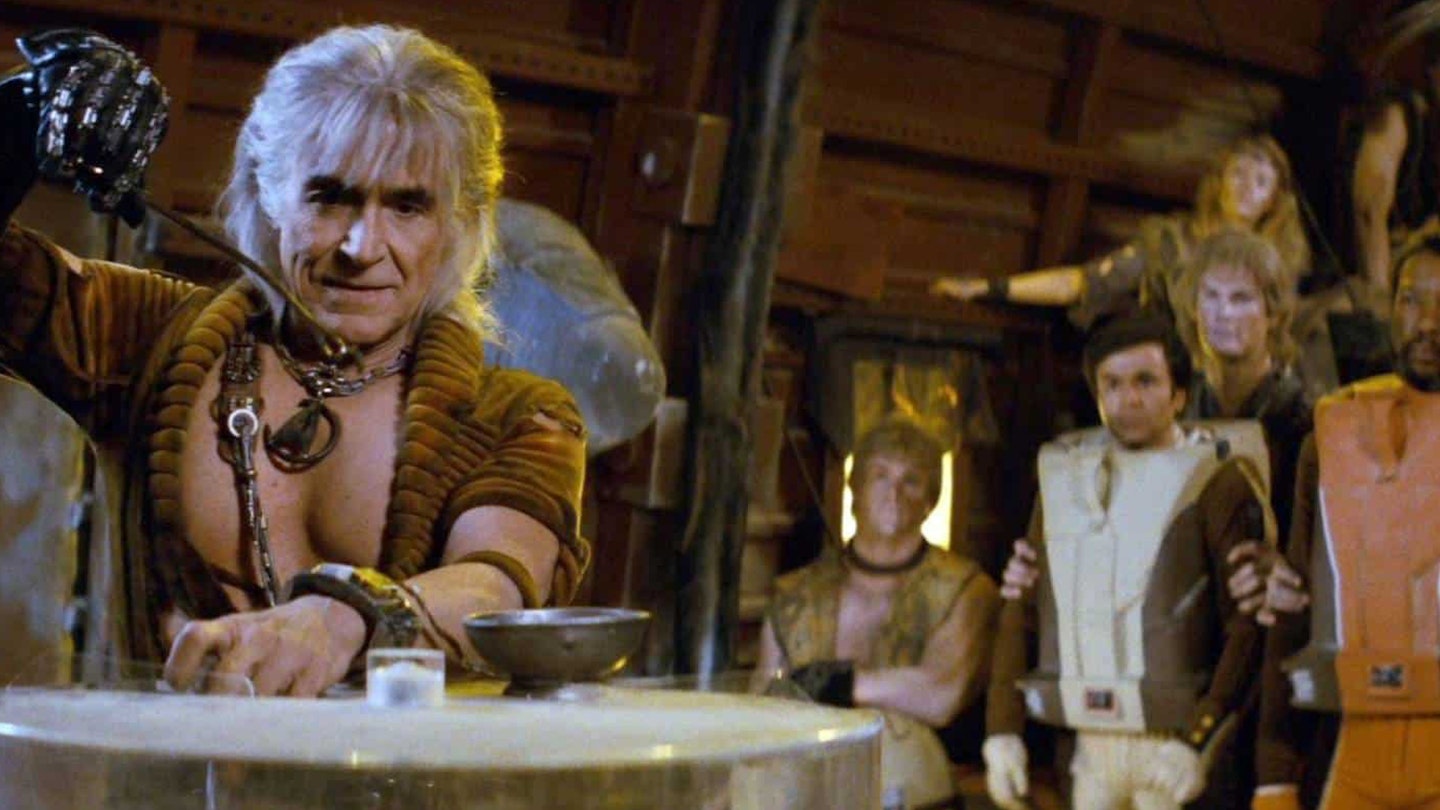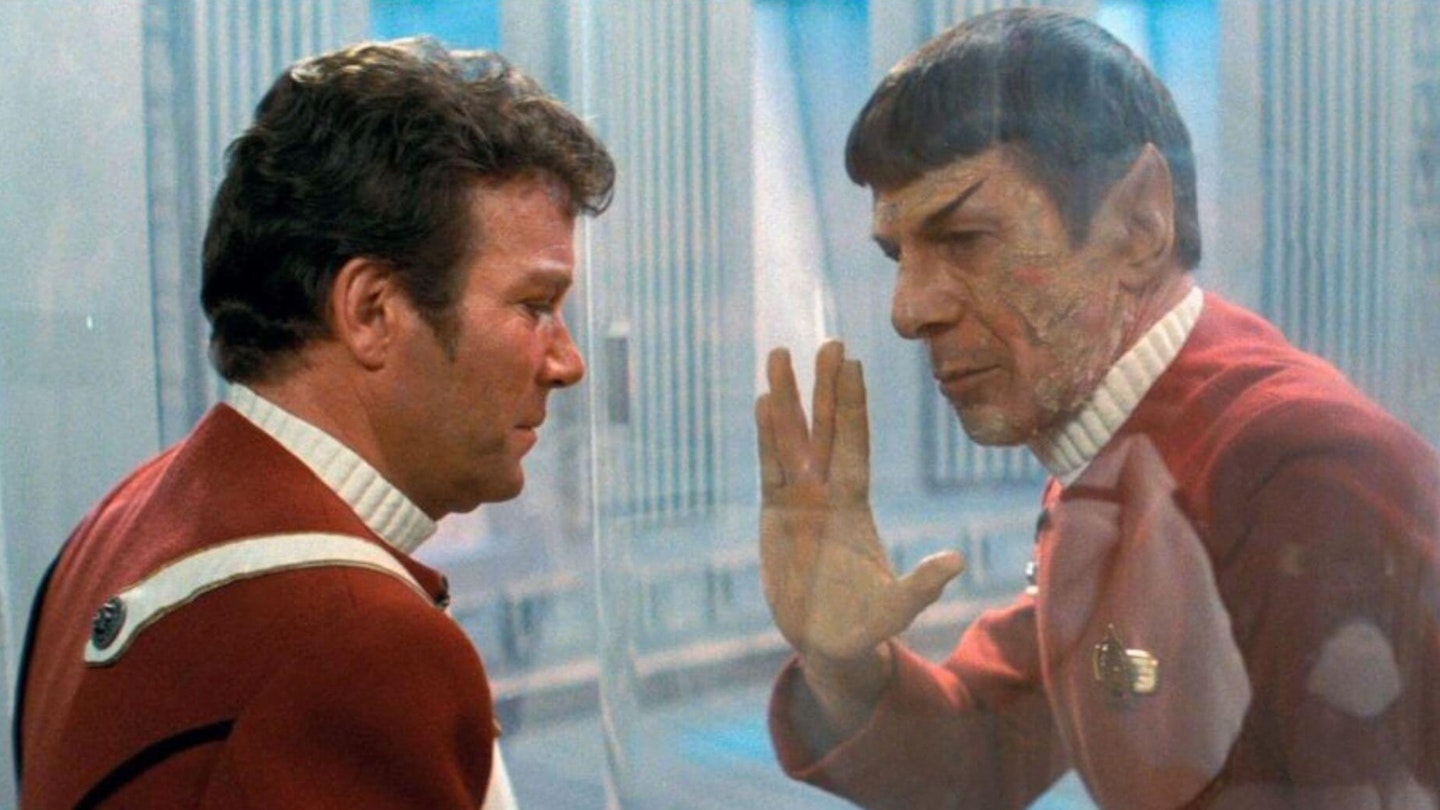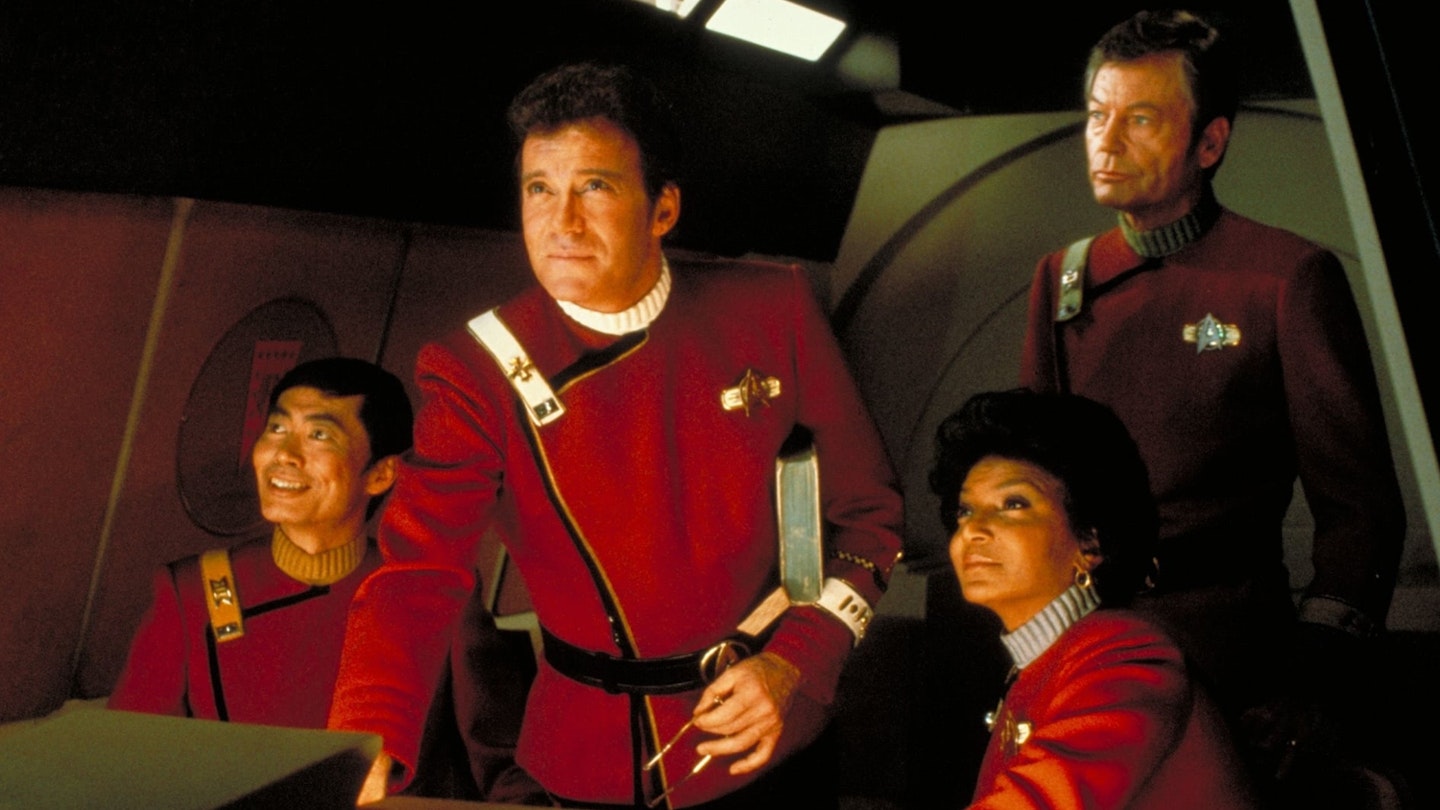40 years ago, the future of Star Trek was hanging in the balance. The TV series had been cancelled in 1969, and an attempted revival with 1979’s Star Trek: The Motion Picture had been less than successful. The second film – grudgingly greenlit by its studio on a vastly reduced budget – was itself drifting into the seas of troubled production until, at the eleventh hour, director Nicholas Meyer came aboard. With Star Trek II: The Wrath of Khan, he not only saved the film, but the franchise.
The story has been repeated so often it’s now a cliche: Gene Roddenberry first pitched Star Trek to the NBC network as ‘Wagon Train to the stars’. Roddenberry had experience with television Westerns, having written for Bat Masterson and Jefferson Drum, and contributed an award-winning episode to Have Gun – Will Travel: all part of the extraordinary proliferation of Western series and films that gained popularity in the 1950s and 1960s. Star Trek’s similarity to Wagon Train pretty much begins and ends with it being constructed from self-contained episodes comprising a wider narrative of forward momentum: the wagon train’s journey West, and the Enterprise’s five-year mission. But space as a ‘frontier’ would also have been an immediately graspable concept for 1960s audiences steeped in the language of the Western: a context that these days is easy to miss.

Roddenberry was hustling the studio with an eye on what was popular, and it’s doubtful he ever really envisaged Star Trek as a ‘Space Western’ per se – although Star Trek episodes did occasionally borrow Western tropes: the Enterprise crew visiting settlers scratching a living from the soil of environmentally hostile planets; gunfights (with phasers) and hokey fisticuffs; and there’s the wonky third-season ‘Spectre Of The Gun’, in which Kirk and Spock find themselves in an alien re-creation of the OK Corral. But Roddenberry’s Star Trek was always very plot-driven – the characters often reduced to pegs on which to hang the Big Ideas. By the time of The Motion Picture, he was deep down a rabbit hole of sub-Kubrickian philosophising about post-humanism and transformation: viz the merging of Ilia with V’ger and then with Decker, and the ungraspable alien vastness of V’ger itself. It was all, to coin a pun, alienating to audiences.
Nicholas Meyer's Star Trek would be terror on the high seas – just with spaceships, and no actual sea.
Clearly some rethinking was needed. Roddenberry was kept at arm’s length for the sequel, and although he isn’t credited for having done so, Meyer entirely re-wrote The Wrath Of Khan’s screenplay according to his own whims. Far from a Western or another 2001, his take was that Star Trek was ‘Hornblower in space’ – referring to CS Forester’s hero of a dozen novels and various adaptations, most recently on ITV in the early 2000s: an adventuresome naval officer during the Napoleonic Wars. Meyer had previously penned the Sherlock-Holmes-meets-Freud novel and screenplay The Seven Percent Solution, and written and directed the HG-Wells-meets-Jack-the-Ripper time travel romp Time After Time. Conceptual mash-ups were his thing (and he’s continued to write novels in which Sherlock Holmes has met the likes of The Mummy and Bram Stoker). His Star Trek would be terror on the high seas – just with spaceships, and no actual sea.
The Wrath Of Khan doesn’t require any detailed Trek knowledge from a more general audience. You don’t even need to have seen Space Seed, the 1966 first-season episode in which Khan originally appeared. Despite the Roman numeral in its title, Star Trek II is a perfect jumping-on point for people who’ve never boldly gone into an episode of Star Trek before. Everything you need, you already have through cultural osmosis. Oddly, there’s barely even any sci-fi in it – obviously, it’s set in space, on spaceships and, briefly, on a couple of strange new worlds, but there are no androids or robots, and aside from the Vulcans and mind-altering earwig thing (sorry, ‘Ceti Eel’), no aliens. Khan and his crew are human ‘augments’, but you don’t even get much sense of that beyond Khan’s stated age, his distracting rock-solid cleavage, and his ability to lift people up with one arm.

Instead of technobabble, the terminology and iconography is much more obviously naval than previously. The language is instantly recognisable as that of the sea: ship, dock, admiral, “plot a course”, bow, stern, helm, shore leave, “belay that order”, and these are, of course, the voyages of the Good Ship Enterprise… Khan, reconfigured for the film as a loony pirate captain, tells Kirk that he’s “marooned” him, as if on some rocky Pacific island. Kirk has a rack of what look like flintlock pistols on the wall of his ready room, not to mention a scale model of a ship in full sail. Kirk reads Dickens, but Khan has a copy of Moby Dick.
The buccaneering score evokes nothing so much as open oceans and the wind in your sails.
The new uniforms too – actually The Motion Picture uniforms dyed burgundy – now incorporate naval-style turtlenecks and rank insignia. And there’s also James Horner’s extraordinary soundtrack, replacing Alexander Courage’s famous TV music and Jerry Goldsmith’s rather martial Motion Picture theme (later used for The Next Generation) with a buccaneering score that evokes nothing so much as open oceans and the wind in in your sails. It’s so massive and lush that it goes a long way to making The Wrath Of Khan seem like a huge movie, when, with the sound off, it actually looks rather small.
As Khan, Ricardo Montalban – a former Mexican heartthrob who found fame in US film and television in a variety of nonsense – was only on set for ten days and has surprisingly few scenes (and none with Kirk that aren’t over a view screen, meaning they never share the same physical space). But he feels like a serious threat because the movie tells you he is, and he looms in your memory thanks to the sheer size and eccentricity of his performance. His dialogue is ridiculous (“He tasks me and I will have him!”) but even when he’s being quiet, there’s an insane menace to him. Stories from behind the scenes suggest that the rest of the cast were coasting a bit until Montalban’s mad intensity goaded them into upping their game.

And thankfully, the material was there to meet their new-found enthusiasm, Meyer leaning into the characters in a way that Roddenberry never really had. As much as it’s about ship battles, The Wrath Of Khan is about the interpersonal relationships and enduring friendships of the crew, particularly Kirk, Spock and McCoy, dealing with ageing and exhaustion and – by the end of the film – loss. Maybe that renewed focus on its actual people is the film’s greatest Star Trek legacy.
Well, that and “KHAAAAAAAAN!”
Star Trek II: The Wrath Of Khan – Director's Cut is in UK cinemas and on 4K Ultra-HD now
